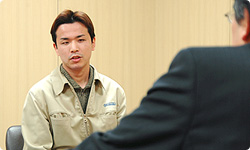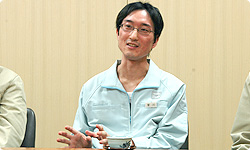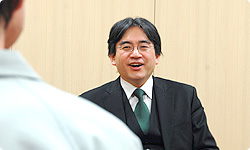2. Gentle Encouragement for Hard Workers
I’d like to ask you about the sound first. I think that the music in the Zelda games is emphasised quite a bit, as it’s designed to play in a fantasy world and give added impact to the emotions felt by the player. However, users of Wii Fit will be listening to the same music on a daily basis, so the music for this game shouldn’t stand out quite as much. Also, I would think that music that will be listened to every day should be something enjoyable, not something that will get on your nerves. In that regard, it must have been difficult to create the kind of sound that, unlike with Zelda, needed to put users in a pleasant mood on a daily basis.
It’s true that with the Zelda games, some people play just so they can listen to the music, so sometimes we needed to really emphasise the overall sound. But with Wii Fit, I needed to back off a bit and create the kind of music that would support the game rather than stand out on its own. Add to that the fact that players would be physically interacting with the game instead of sitting down…
I know, especially with Yoga. I start sweating even if the poses are pretty simple.
I think that with exercise, you need to have both physical and mental endurance. You want customers using Wii Fit every day, but some customers might start to see it as a chore. That’s why when I was composing the music, I focused on soothing the mind and gently encouraging users who manage to continue without giving up rather than trying to make it exciting. I had also noticed that the overall colour scheme of most of the screens (apart from the Balance Games), such as Wii Fit Plaza9 and the main menu screen, was very white and came off a bit cold. 9 The screen where you can view the weight, BMI and training histories of up to eight friends and family members who can register with Wii Fit.
A step too far could have made the game a very colourless place to be.
Yes. That’s why I decided not to emphasise that coldness, but rather to compensate for it by offering something warm, embracing and gentle.

Something that could include the entire family.
Yes. I wanted to create the kind of music that would support you, that would give you the impression that someone was encouraging you to go on or congratulating you on a job well done.
Is it very easy to make that kind of music?
I had to work on it many times before getting it right. For example, I’d initially decided to use nothing but live instruments to produce that warmth, but as a result the music started going in a completely different direction than the on-screen design, and it just felt jarring. So to give the music a more expansive feel and to make sure it didn’t deviate too much from the tone of the graphics, I added subtle bits of synthesiser music, for example.
Creating music that needs to be heard every day has its own unique challenges, it seems. What about you, Miyagawa-san? What difficulties did you experience in creating the sound effects?
I had mentally prepared myself before beginning this project not to rely too much on my experiences with the Zelda games. For example, on Twilight Princess I created the screams of the characters that Oyama-san designed. He kept producing all kinds of creatures and insects that I’d never seen in my life, so I had to constantly continue to create and test all kinds of bizarre sounds. But suddenly, I found myself in a very gentle world. Crossing that gap was really difficult. (laughs)
(laugh)
One thing I particularly spent a lot of time with were the congratulatory sound effects to make the player feel good and the “too bad!” sound effects that would come up if the player didn’t do very well. I wasn’t concerned about having too many congratulatory sounds, as they would simply make people happier. The “too bad” sounds, however, needed to be fine-tuned because players would be hearing these effects on a daily basis. You know how in quiz shows, when someone gets a question wrong you often hear this buzzing sound? I wanted to avoid anything like that. I wanted to create sound effects that would indicate at once that the player didn’t do well but at the same time not put off the player. I put a lot of thought into those sound effects.

I see. It’s difficult to exercise properly if you’re not used to physical activity, so some people would naturally not do very well at first. If they’re assaulted by annoying noises every time they make a mistake, they’ll probably lose the motivation to continue. In other words, you tried to make sure that the sound effects wouldn’t put off people from continuously playing the game.
Right, I wanted to make sure that players would still feel that they were being treated gently even if they made a mistake. The process of inserting the sound effects on its own wasn’t that difficult, because it was basically the same as in the Zelda games.
Did you do anything special with Wii Fit from a sound programming perspective?
Wii Fit includes quite a few of the ideas which (Koji) Kondo-san10 is very serious about that utilise the interactive nature of video games, although doing that is something of a tradition for Nintendo sound teams. Specifically, we’ve designed the sound so that depending on how the player proceeds, Minegishi-san’s background music will change. For example, in Hula Hoop™, the music becomes livelier with every hoop that you catch. 10 Group Manager of the Sound Group who works on the sound design for series such as the Mario and Zelda games.
It really does get livelier the longer you play.
It’s a lot of fun watching someone play Hula Hoop™, but some people might find it difficult to get the hang of it when they try it out because you don’t actually feel the hoops on your waist. The thing is, all you need to do is swing your hips fast, and Hosaka-san, who made this game, wanted us to somehow indicate this through sound. We ended up working on a solution until the very last minute. What we ended up doing was increasing the pitch of the music every time the rotations got faster.
And this way, players can get a feel for the game more naturally. The sound’s not distracting either, it seems to fit perfectly in the game environment.
Yes. With something like Wii Fit, the sound won’t work well if it’s overly expressive or conspicuous. We create sound for the various game screens only after that part of the game design is done, and many people don’t really understand the effect that sounds have on a game. But I know that’s just the way things are, so I motivated myself by telling myself that when a player thinks, “I’m not sure why, but I want to play this again”, or “This really feels great”, sound will have played some small role in that.
I don’t know about “small”. I think sound plays very much a major role in keeping players happy.

That really makes me feel proud of my efforts! (laughs) Another memorable thing about Hula Hoop™ was the mountain of demands that the female staff here gave us… (laughs sheepishly)
Well, then. I suggest we get all the details from them later on! (laughs) This isn’t really a sound effect, but whenever you are invited to get on the Wii Balance Board it says something. There obviously aren’t any bathroom scales in the world that talk, so what I want to know is, how did you manage to create such a lovable voice for it?
I have no idea! (laughs)
(laugh)
All we did was hire a voice actor who fit the image we were going for so we wouldn’t have to alter it much later.
Sometimes it talks normally, but most of the time it seems to be speaking in funny noises . The strange part is it doesn’t irritate me at all.
There’s a lot of Wii Balance Board dialogue that appears on-screen, but I think if all of it was read out, most people would have found it very irritating. That’s why we decided to have the Wii Balance Board speak out only at certain points. It took us a lot of time to find the right balance.
We even adjusted the funny noises to give them a more conversational rhythm.
I see! That must be why they don’t grate on the ear.
Hula Hoop™ and the Hula Hoop logo are trademarks of Wham-O, Inc. All rights reserved.